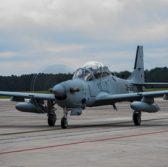 The U.S. Air Force has announced plans to further test non-developmental aircraft offerings from Textron Aviation and the Sierra Nevada–Embraer team through the second phase of the Light Attack Experiment program.
The U.S. Air Force has announced plans to further test non-developmental aircraft offerings from Textron Aviation and the Sierra Nevada–Embraer team through the second phase of the Light Attack Experiment program.
The service branch said Friday it will continue to experiment with Textron’s AT-6 Wolverine as well as Sierra Nevada and Embraer’s A-29 Super Tucano at Davis-Monthan Air Force Base in Arizona from May to July.
“Rather than do a combat demonstration, we have decided to work closely with industry to experiment with maintenance, data networking and sensors with the two most promising light attack aircraft,” said Air Force Secretary Heather Wilson.
“This will let us gather the data needed for a rapid procurement,” added Wilson, a 2018 Wash100 recipient.
Gen. David Goldfein, chief of staff of the Air Force, said the service branch seeks to find a light attack aircraft platform in accordance with the National Defense Strategy.
Phase 2 of the experimentation will assess logistics and maintenance needs, weapons and sensors, training syllabus validity, networking and future interoperability with allied forces.
The service branch also plans to explore methods to expedite development and operation of a network that can facilitate aircraft communications with command-and-control nodes and joint and multi-national forces.
Pilots flew A-29 and AT-6 planes along with a Scorpion jet from Textron Aviation and an AT-802 Longsword from the Air Tractor–L3 Technologies alliance during the first experimentation that occurred in August.
The Air Force noted it will use data from light attack experiments as it considers procurement of new aircraft through a potential industry competition.




